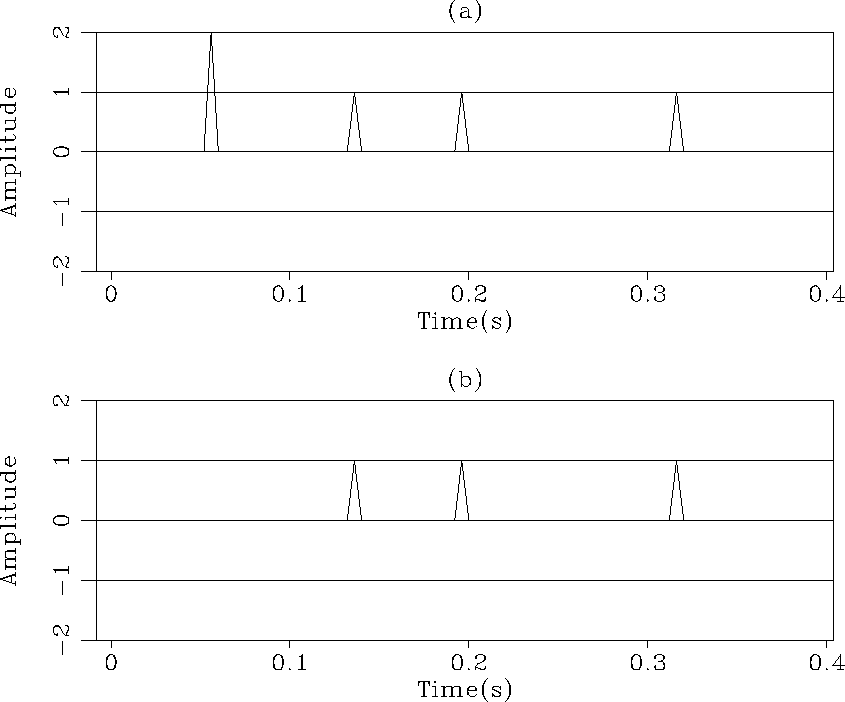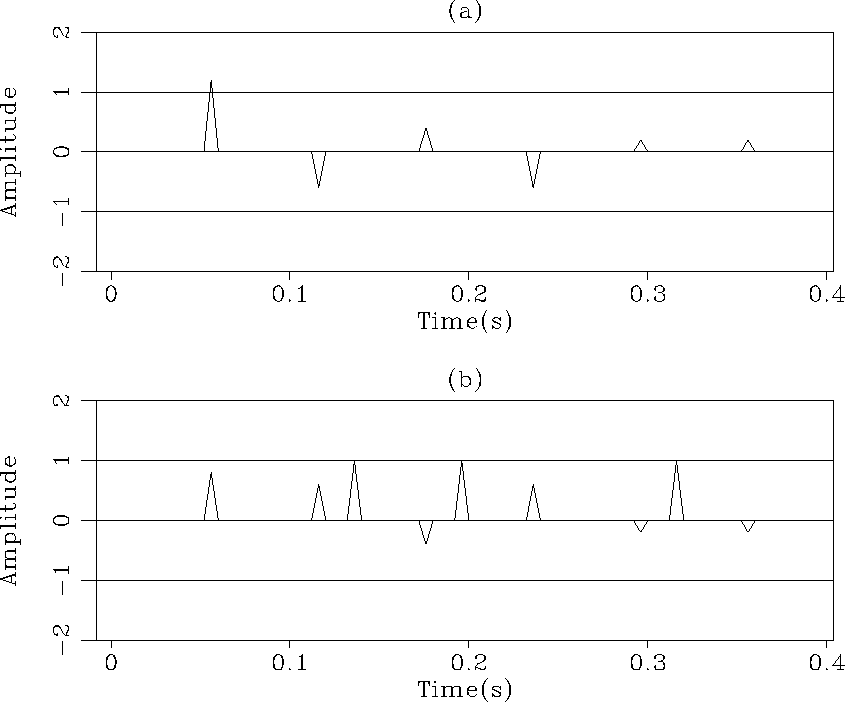




Next: Shaping filters and the
Up: Principles of norm and
Previous: Principles of norm and
This section illustrates some limitations of the  norm
for the estimation of shaping filters.
In figure
norm
for the estimation of shaping filters.
In figure ![[*]](http://sepwww.stanford.edu/latex2html/cross_ref_motif.gif) , a simple 1-D problem is shown.
On the top we have four events corresponding to one primary
(on the left) and three multiples (on the right). Note that the primary has
higher amplitude than the multiples. On the bottom we
show a multiple model that exactly corresponds to the real multiples.
Our goal is to estimate one shaping filter
, a simple 1-D problem is shown.
On the top we have four events corresponding to one primary
(on the left) and three multiples (on the right). Note that the primary has
higher amplitude than the multiples. On the bottom we
show a multiple model that exactly corresponds to the real multiples.
Our goal is to estimate one shaping filter  that minimizes
the objective function
that minimizes
the objective function
|  |
(9) |
where  is the matrix representing the convolution with
the time series for the multiple model (Figure
is the matrix representing the convolution with
the time series for the multiple model (Figure
![[*]](http://sepwww.stanford.edu/latex2html/cross_ref_motif.gif) b) and
b) and  the time
series for the data (Figure
the time
series for the data (Figure ![[*]](http://sepwww.stanford.edu/latex2html/cross_ref_motif.gif) a).
Now, if the filter
a).
Now, if the filter  is estimated with enough degrees of freedom
(enough coefficients) to minimize equation (
is estimated with enough degrees of freedom
(enough coefficients) to minimize equation (![[*]](http://sepwww.stanford.edu/latex2html/cross_ref_motif.gif) ),
we obtain for the estimated primaries, i.e.,
),
we obtain for the estimated primaries, i.e.,  ,
Figure
,
Figure ![[*]](http://sepwww.stanford.edu/latex2html/cross_ref_motif.gif) a, and for the estimated multiples, i.e.,
a, and for the estimated multiples, i.e.,  , Figure
, Figure ![[*]](http://sepwww.stanford.edu/latex2html/cross_ref_motif.gif) b.
The estimated primaries do not resemble the primary in Figure
b.
The estimated primaries do not resemble the primary in Figure ![[*]](http://sepwww.stanford.edu/latex2html/cross_ref_motif.gif) a.
I show the corresponding shaping filter in Figure
a.
I show the corresponding shaping filter in Figure ![[*]](http://sepwww.stanford.edu/latex2html/cross_ref_motif.gif) .
datmul
.
datmul
Figure 1 (a) The data with one
primary on the left, and three multiples on the right. (b) The
multiple model that we want to adaptively subtract from (a).




 1Dl2
1Dl2
Figure 2 (a) The signal estimated with the
 norm. (b) The noise estimated with the
norm. (b) The noise estimated with the  norm.
norm.





This filter is not an unit spike at lag=0 as expected. The problem stems from
the least-squares criterion which yields an estimated signal that has, by definition,
minimum energy. In this 1-D case, the total energy in the estimated
signal (Figure ![[*]](http://sepwww.stanford.edu/latex2html/cross_ref_motif.gif) a) is e2=2.4, which is less than the
total energy of the primary alone
(e2=4). This is a fundamental problem if we use the
a) is e2=2.4, which is less than the
total energy of the primary alone
(e2=4). This is a fundamental problem if we use the  norm to
estimate the shaping filter. In the next section, I show that the
norm to
estimate the shaping filter. In the next section, I show that the
 norm should be used if amplitude differences exist between primaries
and multiples.
norm should be used if amplitude differences exist between primaries
and multiples.





Next: Shaping filters and the
Up: Principles of norm and
Previous: Principles of norm and
Stanford Exploration Project
5/5/2005
![[*]](http://sepwww.stanford.edu/latex2html/cross_ref_motif.gif) , a simple 1-D problem is shown.
On the top we have four events corresponding to one primary
(on the left) and three multiples (on the right). Note that the primary has
higher amplitude than the multiples. On the bottom we
show a multiple model that exactly corresponds to the real multiples.
Our goal is to estimate one shaping filter
, a simple 1-D problem is shown.
On the top we have four events corresponding to one primary
(on the left) and three multiples (on the right). Note that the primary has
higher amplitude than the multiples. On the bottom we
show a multiple model that exactly corresponds to the real multiples.
Our goal is to estimate one shaping filter ![[*]](http://sepwww.stanford.edu/latex2html/cross_ref_motif.gif) b) and
b) and ![[*]](http://sepwww.stanford.edu/latex2html/cross_ref_motif.gif) a).
Now, if the filter
a).
Now, if the filter ![[*]](http://sepwww.stanford.edu/latex2html/cross_ref_motif.gif) ),
we obtain for the estimated primaries, i.e.,
),
we obtain for the estimated primaries, i.e., ![[*]](http://sepwww.stanford.edu/latex2html/cross_ref_motif.gif) a, and for the estimated multiples, i.e.,
a, and for the estimated multiples, i.e., ![[*]](http://sepwww.stanford.edu/latex2html/cross_ref_motif.gif) b.
The estimated primaries do not resemble the primary in Figure
b.
The estimated primaries do not resemble the primary in Figure ![[*]](http://sepwww.stanford.edu/latex2html/cross_ref_motif.gif) a.
I show the corresponding shaping filter in Figure
a.
I show the corresponding shaping filter in Figure ![[*]](http://sepwww.stanford.edu/latex2html/cross_ref_motif.gif) .
.


![[*]](http://sepwww.stanford.edu/latex2html/cross_ref_motif.gif) a) is e2=2.4, which is less than the
total energy of the primary alone
(e2=4). This is a fundamental problem if we use the
a) is e2=2.4, which is less than the
total energy of the primary alone
(e2=4). This is a fundamental problem if we use the ![]() norm to
estimate the shaping filter. In the next section, I show that the
norm to
estimate the shaping filter. In the next section, I show that the
![]() norm should be used if amplitude differences exist between primaries
and multiples.
norm should be used if amplitude differences exist between primaries
and multiples.